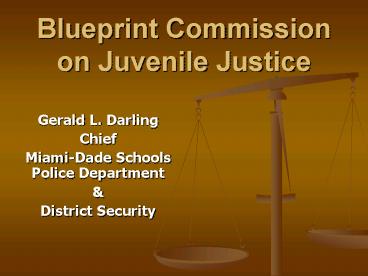Blueprint Commission on Juvenile Justice - PowerPoint PPT Presentation
1 / 11
Title:
Blueprint Commission on Juvenile Justice
Description:
Zero-Tolerance policies have a direct connection with law enforcement functions ... Options must include arrest diversion, specialized programs and services ... – PowerPoint PPT presentation
Number of Views:61
Avg rating:3.0/5.0
Title: Blueprint Commission on Juvenile Justice
1
Blueprint Commission on Juvenile Justice
- Gerald L. Darling
- Chief
- Miami-Dade Schools Police Department
- District Security
2
Miami-Dade County Public Schools Miami-Dade
Schools Police Department
- 4th largest school district in nation
- 350,000 students
- 40,000 employees
- 400 sites
- 5th largest police agency in county
- 220 sworn personnel
- Full service police department
3
Florida's Zero-Tolerance Policy
- Required for serious criminal offenses and/or
administrative violations i.e., weapons,
narcotics, assaults and batteries on staff
members, etc. - Can be rigid and unforgiving for minor
transgressions, and have unintended results - Must be applied fairly, equally and equitably
throughout school and district, however
consideration should be afforded to factors such
as age, grade, offense type and other intangibles
- Critics state that it symbolizes a movement of
treating youth more like adults - Supporters claim it provides simple and
infallible guidelines
4
Florida's Zero-Tolerance Policy
- Zero-Tolerance is a response to student
misbehavior, but cannot serve as a
one-size-fits-all solution - Zero-Tolerance will result in suspensions and
expulsions, but therein lays the opportunity for
discretion i.e., alternatives to arrests
suspensions, suspension centers and suspension
reduction programs - Zero-Tolerance policies have a direct connection
with law enforcement functions
5
Florida's Zero-Tolerance Policy
- The conversation between academicians and law
enforcement must entail how the application of a
Zero-Tolerance policy can best benefit the
children, system and community both now and in
the future - This conversation must discuss how the two bodies
can mesh ideas for safer schools, higher academic
achievement and improved student-school
connectedness
6
Alternatives and Compliments to Zero-Tolerance
Policies
- Intervention, Prevention and Enforcement as a
last resort - Examining school and community for systemic
problems that serve as catalysts for student
misbehavior and youth violence - Identify early warning signs and risk factors
such as bullying, reading below grade level,
truancy, drug alcohol abuse and other issues - Assess the schools and police agencies for
shortcomings and areas were services can be
improved
7
The Role of Law Enforcement
- Primary role is and will always be centered on
traditional policing and crime reduction - Recognize that school policing is different, and
involves several opportunities not afforded to
conventional police agencies i.e., controlled
environment and real-time data - Options must include arrest diversion,
specialized programs and services and mentoring
8
Models in Miami-Dade County
- Civil Citation Program
- Organized Multi-Agency Truancy Sweeps
- Gun Buy Back Programs
- Strategic Presentations
- Collaboration among School Operations, Student
Services and other law enforcement agencies - Value Based Training for law enforcement
personnel in areas identified as deficiencies - Mentoring programs
- M-PACT for at-risk students or gang members
- Academy themes preparing students to join
workforce after completing school
9
Here is How Some of the Models Work
- Civil Citation began as pilot program and now
expanded countywide for almost all misdemeanors - Truancy Sweeps conducted monthly aboard
METRORAIL and within neighborhoods with support
from school social workers - Strategic Presentations content specific and
delivered to schools based on data reflecting
trends and certain types of incidents - Value Based Training changing how law
enforcement has historically trained officers,
conducting self assessments and emphasizing on
deficiencies such as sensitivity training and
consequences to arrest - Mentoring identifying critical times where
parental supervision is in question, police-youth
relations, tutorial services, Cadet Programs and
other life skills training
10
Crime Suspension Reduction
- 2003-04 school year incident per 1000 students
was 251000 - 2006-07 school year incident per 1000 students
was 81000 - Arrest reduction of over 45
- Serious Targeted Incident reduction of over 47
- Reductions in outdoor suspensions
- Improved attendance supported by monthly truancy
sweeps
11
Zero-Tolerance Policy
- Is it good or bad?
- While school administrators need to address
student behavior and true disciplinary issues,
there are pragmatic concerns in doing this fairly
without absorbing significant consequences that
would parallel mandatory sentencing in a
courtroom setting - Applied correctly and sensibly, with the support
of a law enforcement component done in the same
manner that embraces a philosophy of intervention
and prevention, can enhance safety within schools































